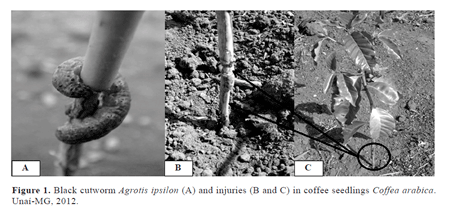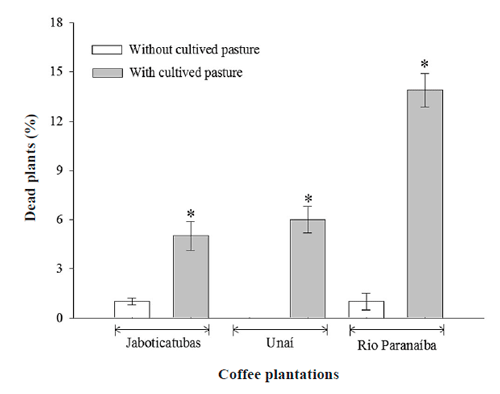Services on Demand
Journal
Article
Indicators
-
 Cited by SciELO
Cited by SciELO -
 Access statistics
Access statistics
Related links
-
 Cited by Google
Cited by Google -
 Similars in
SciELO
Similars in
SciELO -
 Similars in Google
Similars in Google
Share
Revista Colombiana de Entomología
Print version ISSN 0120-0488
Rev. Colomb. Entomol. vol.39 no.1 Bogotá Jan./June 2013
Damage of Agrotis ipsilon (Lepidoptera: Noctuidae)on Coffea arabica in Brazil
Daño de Agrotis ipsilon (Lepidoptera: Noctuidae) en Coffea arabica en Brasil
FLÁVIO L. FERNANDES1,3, JUNO F. S. DINIZ1,3, PAULO R. SILVA1,3 and EDUARDO MOSCA2
1 Dr. in Entomology, Instituto de Ciências Agrárias, Universidade Federal de Viçosa, Campus de Rio Paranaíba, Km 310, Rio Paranaíba, Brazil. flaviofernandes@ufv.br, corresponding author.
2 Agronomist, Centro de Consultoria Araguari, Al das Azaleias , Nº 150, Jardim das rosas, Araguari, Brazil.
3 Graduate student of Agronomy, juno.diniz@ufv.br, paulo.r.roberto@ufv.br.
Received: 5-May-2012 - Accepted: 20-Jun-2013
Abstract: Caterpillars of Agrotis ipsilon (Lepidoptera: Noctuidae) has commonly been found attacking young coffee (Coffea arabica) plants in Brazil (State of Minas Gerais), with lesions being observed in the stems and residues of caterpillar feces found in the bark. A few days after the attack, the tissue damage appears less intense because of a woody suberization and healing process, hampering pest detection. There was a higher mortality of plants (13.9%). This is the first record A. ipsilon damaging young coffee plants in Brazil and new cases could arise in other locations where this plant is grown.
Key words: Black cutworm. Caterpillars. Coffee seedlings. Pasture.
Resumen: Orugas de Agrotis ipsilon son encontradas comúnmente atacando plantas jóvenes de café (Coffea arabica) en Brasil (Estado de Minas Gerais), en las que se observa lesiones en los tallos y se encuentra residuos de heces de oruga en la corteza. Unos pocos días después del ataque, el daño en el tejido parece ser menos intenso a causa de la suberización leñosa y del proceso de curación, lo que dificulta la detección de la plaga. Hubo una elevada mortalidad de la planta (13,9%). Esta es la primera evidencia de que A. ipsilon es dañina a las plantas jóvenes de café en Brasil y que nuevos casos podrían surgir en otras localidades donde se cultiva esta planta.
Palabras clave: Gusano cortador negro. Larvas. Plántulas de café. Pasto.
Introduction
Recent reports have shown new insect pests feeding on and causing problems for coffee plants and other crops in Brazil (Sánchez-Soto 2005; Souza et al. 2009; Fernandes et al. 2010). For example, Scaptocoris castanea (Perty, 1830) (Hemiptera: Cydnidae) occurs sporadically in soy crops (Glycine max L.) and since 1984 has become an important pest in soy, cotton, second crop corn and rice plantations, mainly in the Brazilian states of Mato Grosso, São Paulo and Minas Gerais (Nakano et al. 2001; Oliveira et al. 2003). Thus, new insect species feeding on coffee plants may present a risk in Brazil and other countries.
Caterpillars of the genus Agrotis measure about 40 mm when fully grown, are robust, cylindrical, smooth and dark gray. When touched, they roll up, becoming thread-like in appearance. The larval cycle lasts 20 to 25 days and the pupal stage ranges from 11 to 15 days. This genus constitutes an important group of insect pests because of the damage they cause to a large number of cultivated plants and their wide geographical distribution (Vendramim et al. 1982). Agrotis ipsilon (Hufnagel, 1767) (Lepidoptera: Noctuidae) is the main caterpillar species in Brazil and is a polyphagous insect, attacking mainly Solanaceae, Cruciferae and Curcubitaceae. It can also attack other species of different plant families in crops such as corn and soybeans. A. ipsilon occurs mainly in wetter areas and has great reproductive capacity, with each female capable of laying over 1,000 eggs (Santos and Shield 1998).
Between November 2009 and March 2011, in the municipalities of Unai, Rio Paranaíba and Viçosa, State of Minas Gerais, the black cutworm A. ipsilon has been constantly attacking crops. This has occurred in a field of Coffea arabica L. with six field plantations, with and without cultivated pasture Brachiaria decumbens Stapf and guinea grass Panicum maximum (Fig. 1A). Coffee seedlings were transplanted with 4 - 6 pairs of fully expanded leaves, with 0.6 m between plants and 3.2 m between rows, with a total of 520,833, 200,000 and 1,540 plants in Unai, Rio Paranaíba and Viçosa municipalities, respectively. During the harvest, 200 random transects of plants were established (each 5 m in length) and used to evaluate the percentage of dead plants due to damage by A. ipsilon per coffee plantation. A t-test was conducted to compare attacks across the three coffee plantations.
Attacks occurred in young coffee plants C. arabica (‘Obatã’) approximately 3-4 months after planting, with lesions being observed in the stems (10 cm above the soil) and residues of caterpillar feces found in the bark (Figs. 1A, B, C). A few days after the attack, the tissue damage appears less intense because of a woody suberization and healing process, hampering pest detection. Two problems have been detected arising from this phytophagous pest: One year after the lesions formed, the leaves turned yellow and fell off the plant (Fig. 1C), probably because of increased nutritional requirements during this period. The damage also caused mortality of young plants due to the weakening of the stem region, where the caterpillars were feeding. The damage has also caused weakened young plants, making them more susceptible to being destroyed by wind.
The number of dead plants by A. ipsilon was significantly different between field plantations (P < 0.001). There was a higher mortality (26,000 plants = 13.9%) in Rio Paranaíba, MG (Fig. 2). Probably because there is extensive cultivation of pasture, near the farm assessed. The few studies reporting its damage refer to this species in other plant species, having been detected losses of 50 to 100% (Reis and Hodges 1976).
The damage by A. ipsilon on C. arabica seedlings indicated the potential of this arthropod as a pest on this plant species. More studies must be carried out to determine the growth rate of this species and to evaluate potential losses to C. arabica crops. This is the first record A. ipsilon damaging young coffee plants in Brazil and new cases could arise in other locations where this plant is grown.
Acknowledgements
To Conselho Nacional de Desenvolvimento Científico e Tecnológico (CNPq), Coordenação de Aperfeiçoamento de Pessoal de Nível Superior (CAPES) and Fundação de Amparo à Pesquisa do Estado de Minas Gerais (FAPEMIG) for financial support to the authors.
Literature cited
FERNANDES, F. L.; PICANÇO, M. C.; RAMOS, R. S.; BENEVENUTE, J. S.; FERNANDES, M. E.S. 2010. Ocorrência e distribuição espacial e temporal do coleóptero Naupactus curtus em cafeeiros de Minas Gerais Brasil. Ciência Brasil 40 (6): 1424-1427. [ Links ]
NAKANO, O.; ROMANO, F. C. B.; PESSINI, M. M. O. 2001. Pragas de solo (2nd ed.). Esalq. Piracicaba, Brazil, 213 p. [ Links ]
OLIVEIRA, E. D. M. D.; PASINI, A.; FONSECA, I. C. B. 2003. Association of the soil bug Atarsocoris sp. (Hemiptera: Cydnidae) with the weed Senecio brasiliensis Less. Neotropical Entomology 32 (1): 155-157. [ Links ]
REIS, M. S.; HODGES, C. B. 1976. Forest development and research - Brazil, status of forest diseases and insects in Latin American. Brasília, Brasil, 10 p. [ Links ]
SANTOS, L.; SHIELDS, E. J. 1998. Temperature and diet effect on black cutworm (Lepidoptera: Noctuidae) larval development. Journal of Economic Entomology 91 (1): 267-273. [ Links ]
SÁNCHEZ-SOTO, S.; GUEDE, S. J. C.; NAKANO, O. 2005. Ocorrência de Naupactus curtus Boheman (Coleoptera: Curculionidae) em três plantas de importância econômica no Brasil. Neotropical Entomology 34 (4): 693-693. [ Links ]
SOUZA, A. C. R.; ALMEIDA Jr. E. B. D.; ZICKEL C. S. 2009. Riqueza de espécies de sub-bosque em um fragmento florestal urbano. Biotemas (Brazil) 22 (3): 57-66. [ Links ]
VENDRAMIM, J. D.; FERRAZ, M. C. V. D.; PARRA, J. R. P. 1982. Biologia comparada de Agrotis subterranea (F.) em meios natural e artificial. Solo (Brazil) 74 (1): 76-80. [ Links ]















